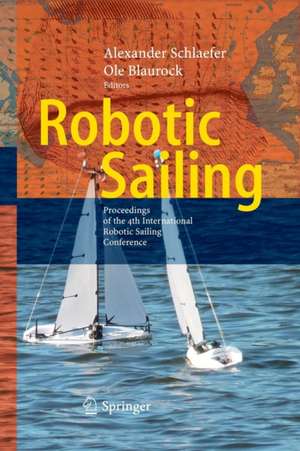Robotic Sailing: Proceedings of the 4th International Robotic Sailing Conference
Editat de Alexander Schlaefer, Ole Blaurocken Limba Engleză Paperback – 22 aug 2016
These proceedings summarize the state of the art as presented at the International Robotic Sailing Conference 2011. Following an overview of the history of autonomous sailing a number of recent boat designs is presented, ranging from small one-design boats to vessels built to cross the Atlantic Ocean. Subsequently, various aspects of system design and validation are discussed, further highlighting the interdisciplinary nature of the field. Finally, methods for collision avoidance, localization and route planning are covered.
| Toate formatele și edițiile | Preț | Express |
|---|---|---|
| Paperback (1) | 1212.98 lei 6-8 săpt. | |
| Springer Berlin, Heidelberg – 22 aug 2016 | 1212.98 lei 6-8 săpt. | |
| Hardback (1) | 1216.48 lei 6-8 săpt. | |
| Springer Berlin, Heidelberg – 14 iul 2011 | 1216.48 lei 6-8 săpt. |
Preț: 1212.98 lei
Preț vechi: 1479.25 lei
-18% Nou
Puncte Express: 1819
Preț estimativ în valută:
232.11€ • 242.95$ • 193.18£
232.11€ • 242.95$ • 193.18£
Carte tipărită la comandă
Livrare economică 31 martie-14 aprilie
Preluare comenzi: 021 569.72.76
Specificații
ISBN-13: 9783662507629
ISBN-10: 3662507625
Pagini: 205
Ilustrații: X, 205 p.
Dimensiuni: 155 x 235 mm
Greutate: 0.31 kg
Ediția:Softcover reprint of the original 1st ed. 2011
Editura: Springer Berlin, Heidelberg
Colecția Springer
Locul publicării:Berlin, Heidelberg, Germany
ISBN-10: 3662507625
Pagini: 205
Ilustrații: X, 205 p.
Dimensiuni: 155 x 235 mm
Greutate: 0.31 kg
Ediția:Softcover reprint of the original 1st ed. 2011
Editura: Springer Berlin, Heidelberg
Colecția Springer
Locul publicării:Berlin, Heidelberg, Germany
Cuprins
Part I Introduction.- Part II Robotic Sailboats.- Part III System Development.- Part IV Collision Avoidance.- Part V Localization and Route Planning.
Textul de pe ultima copertă
While sailing has a long tradition, both as a means of transportation and as a sport, robotic sailing is a fairly new area of research. One of its unique characteristics is the use of wind for propulsion. On the one hand, this allows for long range and long term autonomy. On the other hand, the dependency on changing winds presents a serious challenge for short and long term planning, collision avoidance, and boat control. Moreover, building a robust and seaworthy sailing robot is no simple task, leading to a truly interdisciplinary engineering problem.
These proceedings summarize the state of the art as presented at the International Robotic Sailing Conference 2011. Following an overview of the history of autonomous sailing a number of recent boat designs is presented, ranging from small one-design boats to vessels built to cross the Atlantic Ocean. Subsequently, various aspects of system design and validation are discussed, further highlighting the interdisciplinary nature of the field. Finally, methods for collision avoidance, localization and route planning are covered.
These proceedings summarize the state of the art as presented at the International Robotic Sailing Conference 2011. Following an overview of the history of autonomous sailing a number of recent boat designs is presented, ranging from small one-design boats to vessels built to cross the Atlantic Ocean. Subsequently, various aspects of system design and validation are discussed, further highlighting the interdisciplinary nature of the field. Finally, methods for collision avoidance, localization and route planning are covered.
Caracteristici
Recent research in Robotic Sailing Proceedings of the 4th World Robtotic Sailing championship with the accompanying International Robotic Sailing Conference WRSC/IRSC
WRSC/IRSC held in Lübeck in August 2011
Written by leading experts in the field
WRSC/IRSC held in Lübeck in August 2011
Written by leading experts in the field








